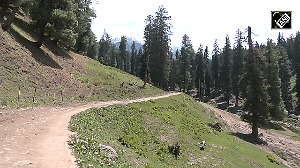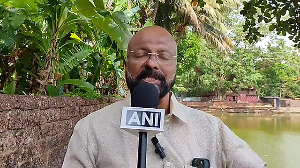The United States is determined to keep this partnership going and growing. And that means working together, says Secretary of State Hillary Clinton in an exclusive article to Rediff.com
This week, leaders from India and the United States will gather in Washington to discuss our expanding cooperation on everything from trade to technology to terrorism. There also will be issues on which we don't see eye to eye, and some of those may dominate the media coverage. But if we look at the trend-lines as well as the headlines, a much more important story emerges: The strategic fundamentals of our relationship shared democratic values, economic imperatives and diplomatic priorities are pushing both countries' interests into closer convergence. The world's oldest democracy and the world's largest democracy are entering a new, more mature phase in our relationship.
The most important bond between our two nations continues to be our common democratic heritage. We are both big, diverse, noisy democracies, committed to pluralism, freedom, and opportunity. Yet, for many decades, our economic and strategic policies often diverged. Only after the end of the Cold War, with India's rapid economic development and growing regional leadership, did the trajectory of our relationship begin to change.
India's expanding GDP, thriving private sector, emerging consumer class, and increasing diplomatic clout have all combined to make it a global power with a big stake in maintaining international security and prosperity. As a result, we find ourselves sharing more than just common values and political systems -- we also increasingly share common interests in an open, free, fair, and transparent global economic system; peace and prosperity in South Asia and the Asia-Pacific; and a coordinated international response to violent extremism and other shared global challenges.
A bipartisan commitment across successive American and Indian administrations has driven a steady improvement in relations, marked by high-profile visits like the one my husband took to India in 2000 and achievements such as President Bush's landmark civilian nuclear cooperation agreement. Today, under President Obama and Prime Minister Singh's leadership, we are continuing those efforts. There is less need for dramatic breakthroughs and more need for steady, focused cooperation. So together, we are building a mature partnership defined by near-constant consultation aimed at working through our differences and advancing the interests and values we share. This kind of daily collaboration isn't always glamorous, but it is strategically significant -- and a long way from the old days of the Cold War.
Let's look at three examples of how this works.
First, on the economic front. Two decades after it began to open its economy, India's industries and innovators have gone global, investing and trading all over the world. Like American businesses, they have come to see that further growth depends on open markets, transparent regulations, and fair mechanisms to settle disputes. And while people in both India and America have important and sometimes conflicting concerns about market access and the effects of globalisation, the benefits of growing economic ties are clear: bilateral trade and investment has reached $100 billion a year, creating jobs and opportunities for Americans and Indians alike. There is much room for growth, and so we need to keep up the momentum, further reducing barriers to trade and investment in areas like multi-brand retail and creating hospitable environments for companies to do business. Because the world's two biggest democracies should have one of the world's most robust and consequential economic relationships.
Second, on Asia. For years, Pakistan and South Asia were a chief focus of India's strategic thinkers. Today, India is also looking east, and playing a larger role in the broader Asia-Pacific. Both India and the United States recognise the strategic and economic significance of the waterways that connect the Indian Ocean through to the Pacific, and the necessity of protecting freedom of navigation. So we are working together and through multilateral institutions such as the East Asia Summit to build a regional architecture that will boost economic growth, settle disputes peacefully, and uphold universal rights and norms. And we are exploring ways to ensure a constructive relationship among the United States, India, and China. Effective cooperation between all three countries will be essential to tackling many of the greatest challenges in the 21st century.
Third, on global challenges like terrorism, climate change, human rights, and nuclear proliferation. Both India and the United States have been targeted by violent extremists, and we understand that defeating terrorist networks takes international coordination and a comprehensive approach that goes after recruits, safe havens, and finances. We also both know that addressing cross-cutting challenges like climate change will require developed and developing countries alike to work together. Even on issues where we have at times disagreed, like human rights in Burma or sanctions on Iran, you can see our new habits of cooperation paying off. India understands the importance of denying Iran a nuclear weapon and supports efforts to ensure Iran's compliance with its international obligations. And India has taken steps to diversify its sources of imported crude by reducing purchases of Iranian oil. At the same time, the US recognises India's energy needs, and we're working together, along with other partners around the world, to ensure stable oil markets that can meet global demand. And that's what a good partnership is all about -- respecting each other's interests and needs and working to find mutually-acceptable approaches to common challenges.
These are just three of the most significant areas in which the strategic fundamentals of our relationship are redefining the US-India partnership. On issue after issue, we find that India's interests and America's interests are lining up.
The effectiveness of this partnership will hinge on our ability together to convert common interests into common action. It's not enough to talk about cooperating on civilian nuclear energy or attracting more US investment in India or defending human rights, we have to follow through so that our people can see the results. And we recognise that some Indians still fear that working closely with the United States will undermine their "strategic autonomy." But at the end of the day, a strategic partnership isn't about one country supporting the policies or priorities of the other. It's about working together on shared goals and preventing short-term disagreements from derailing long-term cooperation.
The United States is determined to keep this partnership going and growing. And that means working together -- including through mechanisms like this week's US-India Strategic Dialogue -- to build trust and deepen the habits of cooperation that will help break through areas of disagreement and bring benefits to the people of both countries.
Together, we can turn strategic fundamentals into strategic partnership.









 © 2025
© 2025